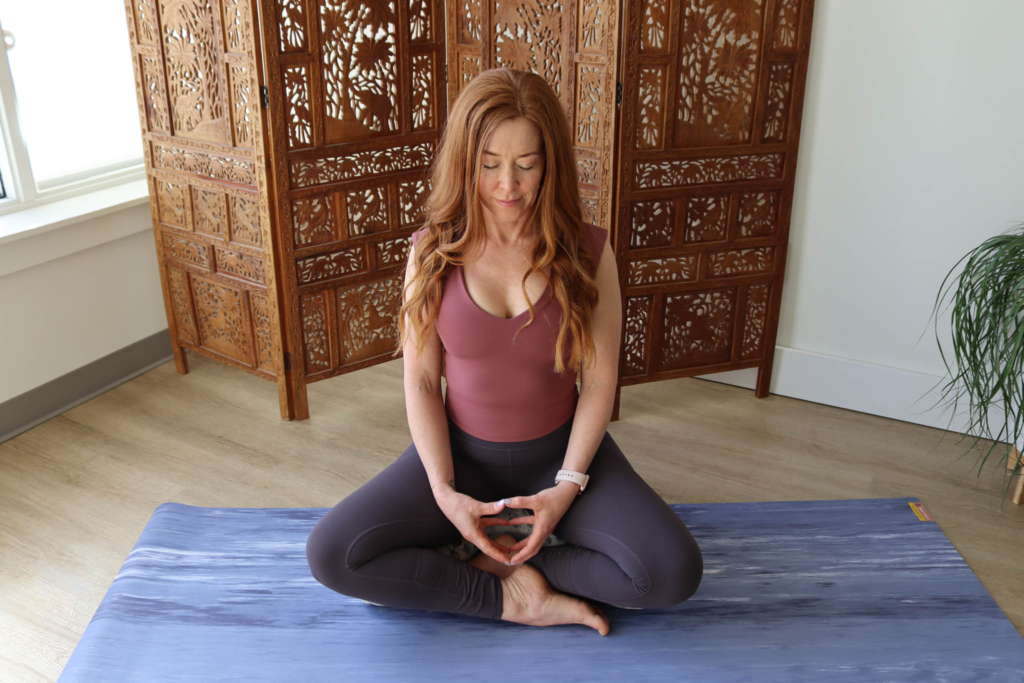This entry was posted on Apr 11, 2024 by Charlotte Bell.

For the first time since last fall, I’m sitting next to an open window as I write. The spring air, with its occasional hints of blooming bulbs and trees, is so refreshing. While pranayama (yogic breathing practice) is appropriate during all seasons, the clean spring air seems to invite taking a nice deep breath. There are many pranayama practices that incorporate mudras—hand gestures meant to facilitate the movement of prana (the animating force in our bodies and minds). In particular, I enjoy practicing a simple pranayama mudra called Hasta Mudra.
I don’t claim to be an expert on hand mudras. But I do recognize the power of the few that I’ve practiced regularly. I’ve been amazed at the difference subtle changes in hand position can make. Hasta Mudra, in particular, has been a favorite among my yoga students. It shows how seemingly minor changes in touch can bring about changes in breathing that pretty much anyone can easily feel. The hand position is quite simple. Only the degree to which your fingers touch shifts. Hasta Mudra allows you to focus in on different parts of the body’s “breathing spaces.” I learned this breathing mudra from Jenny Otto of Body Balance Yoga Therapy.
First Things First: Healthy Breathing
In general, I’ve avoided writing about pranayama practice simply because it’s best to learn directly from an experienced teacher. Especially in the case of the more complicated or intense practices, it’s possible to overstimulate the nervous system. This can trigger physical, mental and emotional imbalances. So careful, informed instruction is essential.
The breathing practices I feel comfortable sharing veer toward healthy natural breathing. This means slow, deep, relaxed belly breathing. You breathe deeply, but never to the point of strain. As you inhale, the abdomen should expand; as you exhale, it should contract. Nothing fancy here, just relaxed, nourishing breathing. Maintain relaxed, deep breathing as you move through the various stages of Hasta Mudra.
How to Practice Hasta Mudra
- Sit in a comfortable position on a Meditation Cushion or a folded Yoga Blanket. If sitting on the floor is not comfortable for you, feel free to sit on a chair instead. What’s important is that your torso is upright and your natural spinal curves are aligned.
- Settle into your hips and legs and tune into your breathing. As you inhale, allow your abdomen to expand. As you exhale, allow it to contract. Breathe deeply, but in a relaxed way, so there’s no strain.
- Place your fingertips and thumb tips together. Balance the contact between your fingertips so that it’s both firm and receptive.
- Now, continuing with deep, relaxed breathing, press the little fingertips and ring fingertips together a little more firmly than the others. Where do you feel the “center” of your breath happening? In other words, if you imagine your breathing space to be your entire torso, where does the breath feel most prominent? Take about five to 10 breaths.
- Now relax the contact between your ring and pinky fingertips and press your middle fingertips together more firmly than the other fingers. Tune into your torso, and notice where the center of your breath is now. Has it changed? If it’s not clear, go back to pressing your ring and pinky fingertips together more firmly and notice if the center of your breath shifts. Then take five to 10 breaths with your middle fingers pressed a bit more firmly than the others.
- Let go of pressing your middle fingertips more firmly than the others. Now press your thumb tips and index fingertips more firmly. Where is the center of your breath now? Again, feel free to switch back to the middle fingers or the ring and pinky fingers for a breath or two for contrast. Then return to pressing the thumbs and index fingers a bit more firmly. Take five to 10 breaths in this position.
- Now press the fingertips together evenly. Take five to 10 deep breaths, noticing how your breath feels now.
Exploring Hasta Mudra
These variations of Hasta Mudra allow you to access different areas of your breathing space. Most people feel the center of the breath in the lower belly in the first (ring and pinky finger) variation, the middle in the second (middle finger) variation, and the chest in the third (thumb and index finger) variation. The fourth variation, with the fingers pressing together evenly, opens up the entire breathing space. However, it’s possible you may experience this exercise differently. If that’s the case, trust your own experience. Your own experience is your most reliable guide.
If you enjoy Hasta Mudra, play with subdividing your breathing space even further. Try pressing the little fingers, ring fingers, middle fingers, index fingers and thumbs together separately. Notice if that gives you access to smaller breathing space areas.
About Charlotte Bell
Charlotte Bell discovered yoga in 1982 and began teaching in 1986. Charlotte is the author of Mindful Yoga, Mindful Life: A Guide for Everyday Practice and Yoga for Meditators, both published by Rodmell Press. Her third book is titled Hip-Healthy Asana: The Yoga Practitioner’s Guide to Protecting the Hips and Avoiding SI Joint Pain (Shambhala Publications). She writes a monthly column for CATALYST Magazine and serves as editor for Yoga U Online. Charlotte is a founding board member for GreenTREE Yoga, a non-profit that brings yoga to underserved populations. A lifelong musician, Charlotte plays oboe and English horn in the Salt Lake Symphony and folk sextet Red Rock Rondo, whose DVD won two Emmy awards in 2010.

